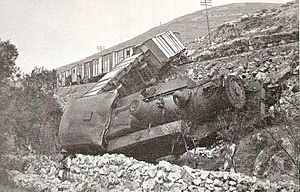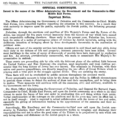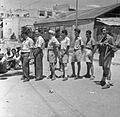Jewish insurgency in Mandatory Palestine facts for kids
Quick facts for kids Jewish insurgency in Mandatory Palestine |
|||||||
|---|---|---|---|---|---|---|---|
| Part of Sectarian conflict in Mandatory Palestine | |||||||
 Palestine Railway K class 2-8-4T steam locomotive and freight train derailed from the Jaffa and Jerusalem line after being sabotaged by Jewish insurgents in 1946 |
|||||||
|
|||||||
| Belligerents | |||||||
|
|
||||||
| Commanders and leaders | |||||||
| Sir Evelyn Barker Sir Alan Cunningham Harold MacMichael Sir Gordon MacMillan John Vereker, 6th Viscount Gort John Rymer-Jones William Nicol Gray |
Menachem Begin Amichai Paglin Yitzhak Shamir Eitan Livni Nathan Yellin-Mor Moshe Sneh Yisrael Galili |
||||||
| Strength | |||||||
| British police: 4,000 policemen British Armed Forces: 100,000 troops (peak strength) |
Haganah: 21,000 troops
Lehi: 500 troops |
||||||
| Casualties and losses | |||||||
| 141 soldiers and police killed (August 1945 – August 1947) | 31 killed 7 executed 2 committed ... (August 1945 – August 1947) |
||||||
The Jewish insurgency in Mandatory Palestine was a period of fighting between Jewish underground groups and the British rulers of Palestine. This conflict happened from 1944 to 1948. It was part of a larger struggle over the future of the land.
The British had controlled Palestine since World War I. They had promised to help create a Jewish homeland there. However, as more Jewish people moved to Palestine, tensions grew. In 1939, the British government released a "White Paper." This document limited how many Jewish people could move to Palestine. It also restricted land purchases by Jewish people. This made many Jewish groups very upset.
Contents
Why Did the Conflict Start?
During World War II, many Jewish groups in Palestine helped the British fight against the Axis powers (Germany, Italy, Japan). But as the war ended, it became clear that Britain would not allow many more Jewish immigrants. They also seemed unwilling to create a Jewish state right away. This led to a rise in armed resistance.
Key Groups Involved
There were several Jewish underground groups:
- Haganah: This was the largest Jewish defense group. It was officially linked to the Jewish leadership in Palestine. For a while, the Haganah worked with the British.
- Irgun: This group broke away from the Haganah. It was a smaller, more radical group. In 1944, the Irgun declared a revolt against British rule.
- Lehi: Also known as the Stern Gang, this was another small, radical group. Lehi had been fighting the British throughout World War II.
These groups attacked British police and government targets. They wanted to force Britain to change its policies on immigration and the future of Palestine.
Important Events During the Insurgency
The conflict had several phases:
- Early Attacks (1944): The Irgun and Lehi began attacking British targets. Lehi even assassinated a British official, Baron Moyne, in 1944.
- The Hunting Season (1944-1945): The Haganah did not agree with the Irgun and Lehi's violent methods. They actively tried to stop these groups. This period of Jewish-on-Jewish conflict was called "the Hunting Season."
- Jewish Resistance Movement (1945-1946): After World War II ended, the Haganah realized Britain wasn't changing its policies. So, the Haganah joined forces with the Irgun and Lehi. They formed the Jewish Resistance Movement. The Haganah focused on helping Jewish immigrants enter Palestine illegally. The Irgun and Lehi attacked military and police targets.
- King David Hotel Bombing (1946): This movement ended after the King David Hotel bombing. The Irgun bombed the British headquarters in Jerusalem, causing many deaths. This event led to the Resistance Movement breaking up.
- Continued Fighting (1946-1948): The Irgun and Lehi continued their independent attacks. The Haganah mainly focused on supporting Jewish immigration. When the United Nations sent a committee to investigate Palestine, the Haganah briefly tried to stop the other groups' operations.
- End of the Mandate (1947-1948): In November 1947, the UN voted to divide Palestine into separate Arab and Jewish states. This led to a civil war between Jewish and Arab communities. Even during this civil war, Jewish groups continued to clash with British forces. The conflict ended when Britain left Palestine and the Israeli Declaration of Independence was made on May 14, 1948.
Who Was Affected?
Many people were hurt or killed during this conflict. This included British soldiers and police, Jewish fighters, and civilians. The fighting also led to more anti-Jewish feelings in the United Kingdom.
Casualties
Here's a look at the casualties from August 1945 to August 1947:
| Killed | Wounded | Total | |
|---|---|---|---|
| British | 141 | 475 | 616 |
| Jewish Insurgents | 40 | 23 | 63 |
| Jewish Others | 25 | 115 | 140 |
| Arabs | 44 | 287 | 331 |
| Others | 10 | 12 | 22 |
| Totals | 260 | 912 | 1172 |
How Did This Conflict Impact the World?
The Jewish insurgency had a big impact beyond Palestine.
Impact on British Relations
Britain had important relationships with Arab countries. These relationships were key for oil and for reaching India through the Suez Canal. The conflict in Palestine made these relationships difficult.
Inspiration for Other Independence Movements
The success of the Jewish groups in fighting for independence inspired others around the world.
- Groups fighting for independence in places like Malaya and Algeria studied the tactics used in Palestine.
- The EOKA group in Cyprus also used methods similar to the Irgun.
- Even Nelson Mandela, who fought against apartheid in South Africa, studied a book by Menachem Begin (an Irgun leader) called The Revolt. He used it to plan his own group's actions.
- The Palestine Liberation Organization also found inspiration from the Irgun's success.
- Years later, in 2001, a copy of The Revolt was found in an Al-Qaeda training camp in Afghanistan. This shows how widely the book was studied.
Images for kids
See also
- 6th Airborne Division in Palestine
- Israel-United Kingdom relations
- List of Irgun attacks
- List of modern conflicts in the Middle East
- Suez Crisis
- Violent conflicts in the British Mandate of Palestine












